Radio-Frequency/Microwave Gas Sensors Using Conducting Polymer
Abstract
1. Introduction
2. Conducting Polymers for Chemical Gas Detection
2.1. Sensing Mechanism of the PPy
2.2. Sensing Mechanism of the PANi
2.3. Sensing Mechanism of the PEDOT
3. Concept of Radio-Frequency/Microwave-Based Chemical Gas Sensor
3.1. Radio-Frequency/Microwave Sensing Parameters
3.2. Radio-Frequency/Microwave Characteristics of Conducting Polymers
3.2.1. Radio-Frequency/Microwave Characteristics of the PANi
3.2.2. Radio-Frequency/Microwave Characteristics of the PPy
3.2.3. Radio-Frequency/Microwave Characteristics of the PEDOT
3.3. Radio-Frequency/Microwave Applications Using Conducting Polymers
4. Radio-Frequency/Microwave Chemical Gas Sensors Using Conducting Polymers
4.1. PANi-Based Radio-Frequency/Microwave Chemical Gas Sensors
4.2. PPy-Based Radio-Frequency/Microwave Chemical Gas Sensors
4.3. PEDOT-Based Radio-Frequency/Microwave Chemical Gas Sensors
5. Summary and Perspective
Author Contributions
Funding
Conflicts of Interest
References
- Guarino, V.; Zuppolini, S.; Borriello, A.; Ambrosio, L. Electro-Active Polymers (EAPs): A Promising Route to Design Bio-Organic/Bioinspired Platforms with on Demand Functionalities. Polymers 2016, 8, 185. [Google Scholar] [CrossRef]
- Nardes, A.; Kemerink, M.; de Kok, M.; Vinken, E.; Maturova, K.; Janssen, R. Conductivity, work function, and environmental stability of PEDOT:PSS thin films treated with sorbitol. Org. Electron. 2008, 9, 727–734. [Google Scholar] [CrossRef]
- Piro, B.; Mattana, G.; Zrig, S.; Anquetin, G.; Battaglini, N.; Capitao, D.; Maurin, A.; Reisberg, S. Fabrication and use of organic electrochemical transistors for sensing of metabolites in aqueous media. Appl. Sci. 2018, 8, 928. [Google Scholar] [CrossRef]
- Nishimura, R.; Tsuru, T.; Ohtsuka, T.; Hara, N.; Han, E.H.; Alyousif, O. Understanding of Corrosion Phenomena: Process, Mechanism, and Method. Int. J. Corros. 2012, 2012, 286174. [Google Scholar] [CrossRef][Green Version]
- Nguyen, V.; Potje-Kamloth, K. Electrical and chemical sensing properties of doped polypyrrole/gold Schottky barrier diodes. Thin Solid Films 1999, 338, 142–148. [Google Scholar] [CrossRef]
- Nguyen, V.; Potje-Kamloth, K. Electrical and NOx gas sensing properties of metallophthalocyanine-doped polypyrrole/silicon heterojunctions. Thin Solid Films 2001, 392, 113–121. [Google Scholar] [CrossRef]
- An, K.H.; Jeong, S.Y.; Hwang, H.R.; Lee, Y.H. Enhanced Sensitivity of a Gas Sensor Incorporating Single-Walled Carbon Nanotube–Polypyrrole Nanocomposites. Adv. Mater. 2004, 16, 1005–1009. [Google Scholar] [CrossRef]
- Kriván, E.; Visy, C.; Dobay, R.; Harsányi, G.; Berkesi, O. Irregular Response of the Polypyrrole Films to H2S. Electroanalysis 2000, 12, 1195–1200. [Google Scholar] [CrossRef]
- Bhat, N.V.; Gadre, A.P.; Bambole, V.A. Investigation of electropolymerized polypyrrole composite film: Characterization and application to gas sensors. J. Appl. Polym. Sci. 2003, 88, 22–29. [Google Scholar] [CrossRef]
- Gustafsson, G.; Lundström, I.; Liedberg, B.; Wu, C.; Inganäs, O.; Wennerström, O. The interaction between ammonia and poly(pyrrole). Synth. Met. 1989, 31, 163–179. [Google Scholar] [CrossRef]
- Guernion, N.; Ewen, R.; Pihlainen, K.; Ratcliffe, N.; Teare, G. The fabrication and characterisation of a highly sensitive polypyrrole sensor and its electrical responses to amines of differing basicity at high humidities. Synth. Met. 2002, 126, 301–310. [Google Scholar] [CrossRef]
- Yoon, H.; Chang, M.; Jang, J. Sensing Behaviors of Polypyrrole Nanotubes Prepared in Reverse Microemulsions: Effects of Transducer Size and Transduction Mechanism. J. Phys. Chem. B 2006, 110, 14074–14077. [Google Scholar] [CrossRef] [PubMed]
- Bhat, N.V.; Gadre, A.P.; Bambole, V.A. Structural, mechanical, and electrical properties of electropolymerized polypyrrole composite films. J. Appl. Polym. Sci. 2001, 80, 2511–2517. [Google Scholar] [CrossRef]
- Šetka, M.; Drbohlavová, J.; Hubálek, J. Nanostructured polypyrrole-based ammonia and volatile organic compound sensors. Sensors 2017, 17, 562. [Google Scholar] [CrossRef] [PubMed]
- Blackwood, D.; Josowicz, M. Work Function and Spectroscopic Studies of Interactions between Conducting Polymers and Organic Vapors. J. Phys. Chem. 1991, 95, 493–502. [Google Scholar] [CrossRef]
- Dixit, V.; Misra, S.; Sharma, B. Carbon monoxide sensitivity of vacuum deposited polyaniline semiconducting thin films. Sens. Actuators B Chem. 2005, 104, 90–93. [Google Scholar] [CrossRef]
- Misra, S.; Mathur, P.; Srivastava, B. Vacuum-deposited nanocrystalline polyaniline thin film sensors for detection of carbon monoxide. Sens. Actuators A Phys. 2004, 114, 30–35. [Google Scholar] [CrossRef]
- Hu, H.; Trejo, M.; Nicho, M.; Saniger, J.; Garcıa-Valenzuela, A. Adsorption kinetics of optochemical NH3 gas sensing with semiconductor polyaniline films. Sens. Actuators B Chem. 2002, 82, 14–23. [Google Scholar] [CrossRef]
- Bekyarova, E.; Davis, M.; Burch, T.; Itkis, M.E.; Zhao, B.; Sunshine, S.; Haddon, R.C. Chemically Functionalized Single-Walled Carbon Nanotubes as Ammonia Sensors. J. Phys. Chem. B 2004, 108, 19717–19720. [Google Scholar] [CrossRef]
- Virji, S.; Huang, J.; Kaner, R.B.; Weiller, B.H. Polyaniline Nanofiber Gas Sensors: Examination of Response Mechanisms. Nano Lett. 2004, 4, 491–496. [Google Scholar] [CrossRef]
- Virji, S.; Fowler, J.; Baker, C.; Huang, J.; Kaner, R.; Weiller, B. Polyaniline Nanofiber Composites with Metal Salts: Chemical Sensors for Hydrogen Sulfide. Small 2005, 1, 624–627. [Google Scholar] [CrossRef] [PubMed]
- Virji, S.; Kaner, R.B.; Weiller, B.H. Hydrogen Sensors Based on Conductivity Changes in Polyaniline Nanofibers. J. Phys. Chem. B 2006, 110, 22266–22270. [Google Scholar] [CrossRef] [PubMed]
- Lee, H.J.; Jeong, N.; Choi, H.H. Microwave Properties of Coplanar Waveguide-Based PEDOT: PSS Conducting Polymer Line in Ethanol Gas Atmosphere. Materials 2020, 13, 1759. [Google Scholar] [CrossRef]
- Pasha, A.; Khasim, S.; Al-Hartomy, O.A.; Lakshmi, M.; Manjunatha, K.G. Highly sensitive ethylene glycol-doped PEDOT–PSS organic thin films for LPG sensing. RSC Adv. 2018, 8, 18074–18083. [Google Scholar] [CrossRef]
- Ouyang, J.; Xu, Q.; Chu, C.W.; Yang, Y.; Li, G.; Shinar, J. On the mechanism of conductivity enhancement in poly(3,4-ethylenedioxythiophene):poly(styrene sulfonate) film through solvent treatment. Polymer 2004, 45, 8443–8450. [Google Scholar] [CrossRef]
- Ouyang, J.; Chu, C.W.; Chen, F.C.; Xu, Q.; Yang, Y. High-Conductivity Poly(3,4-ethylenedioxythiophene): Poly(styrene sulfonate) Film and Its Application in Polymer Optoelectronic Devices. Adv. Funct. Mater. 2005, 15, 203–208. [Google Scholar] [CrossRef]
- Park, J.K.; Hong, Y.; Lee, H.; Jang, C.; Yun, G.H.; Lee, H.J.; Yook, J.G. Noncontact RF Vital Sign Sensor for Continuous Monitoring of Driver Status. IEEE Trans. Biomed. Circuits Syst. 2019, 13, 493–502. [Google Scholar] [CrossRef]
- Jang, C.; Park, J.K.; Lee, H.J.; Yun, G.H.; Yook, J.G. Temperature-Corrected Fluidic Glucose Sensor Based on Microwave Resonator. Sensors 2018, 18, 3850. [Google Scholar] [CrossRef]
- Jang, C.; Park, J.K.; Lee, H.J.; Yun, G.H.; Yook, J.G. Non-invasive Fluidic Glucose Detection Based on Dual Microwave Complementary Split Ring Resonators With a Switching Circuit for Environmental Effect Elimination. IEEE Sens. J. 2020. [Google Scholar] [CrossRef]
- Lee, H.J.; Yook, J.G. Droplet sensing using small and compact high-Q planar resonator based on impedance matching technique. Rev. Sci. Instrum. 2016, 87, 094706. [Google Scholar] [CrossRef]
- Lee, H.; Kim, B.H.; Park, J.K.; Yook, J.G. A Novel Vital-Sign Sensing Algorithm for Multiple Subjects Based on 24-GHz FMCW Doppler Radar. Remote Sens. 2019, 11, 1237. [Google Scholar] [CrossRef]
- Wang, Z.; Bi, H.; Liu, J.; Sun, T.; Wu, X. Magnetic and microwave absorbing properties of polyaniline/γ-Fe2O3 nanocomposite. J. Magn. Magn. Mater. 2008, 320, 2132–2139. [Google Scholar] [CrossRef]
- Abbas, S.; Dixit, A.; Chatterjee, R.; Goel, T. Complex permittivity and microwave absorption properties of BaTiO3–polyaniline composite. Mater. Sci. Eng. B 2005, 123, 167–171. [Google Scholar] [CrossRef]
- Gandhi, N.; Singh, K.; Ohlan, A.; Singh, D.; Dhawan, S. Thermal, dielectric and microwave absorption properties of polyaniline–CoFe2O4 nanocomposites. Compos. Sci. Technol. 2011, 71, 1754–1760. [Google Scholar] [CrossRef]
- Schmidt, C.E.; Shastri, V.R.; Vacanti, J.P.; Langer, R. Stimulation of neurite outgrowth using an electrically conducting polymer. Proc. Natl. Acad. Sci. USA 1997, 94, 8948–8953. [Google Scholar] [CrossRef]
- Wong, J.Y.; Langer, R.; Ingber, D.E. Electrically conducting polymers can noninvasively control the shape and growth of mammalian cells. Proc. Natl. Acad. Sci. USA 1994, 91, 3201–3204. [Google Scholar] [CrossRef]
- Epron, F.; Henry, F.; Sagnes, O. Chemical synthesis and dielectric characterisation in microwave domain of polypyrrole latexes. Makromol. Chem. Macromol. Symp. 1990, 35–36, 527–533. [Google Scholar] [CrossRef]
- Kaynak, A.; Unsworth, J.; Beard, G.E.; Clout, R. Study of conducting polypyrrole films in the microwave region. Mat. Res. Bull. 1993, 28, 1109–1125. [Google Scholar] [CrossRef]
- Kaynak, A.; Unsworth, J.; Clout, R.; Mohan, A.S.; Beard, G.E. A study of microwave transmission, reflection, absorption, and shielding effectiveness of conducting polypyrrole films. J. Appl. Polym. Sci. 1994, 54, 269–278. [Google Scholar] [CrossRef]
- Kros, A.; van Hövell, S.W.F.M.; Sommerdijk, N.A.J.M.; Nolte, R.J.M. Poly(3,4-ethylenedioxythiophene)-Based Glucose Biosensors. Adv. Mater. 2001, 13, 1555–1557. [Google Scholar] [CrossRef]
- Meng, H.; Perepichka, D.F.; Bendikov, M.; Wudl, F.; Pan, G.Z.; Yu, W.; Dong, W.; Brown, S. Solid-State Synthesis of a Conducting Polythiophene via an Unprecedented Heterocyclic Coupling Reaction. J. Am. Chem. Soc. 2003, 125, 15151–15162. [Google Scholar] [CrossRef] [PubMed]
- Ni, X.; Hu, X.; Zhou, S.; Sun, C.; Bai, X.; Chen, P. Synthesis and microwave absorbing properties of poly(3,4-ethylenedioxythiophene) (PEDOT) microspheres. Polym. Advan. Technol. 2011, 22, 532–537. [Google Scholar] [CrossRef]
- Tamburri, E.; Sarti, S.; Orlanducci, S.; Terranova, M.L.; Rossi, M. Study of PEDOT conductive polymer films by admittance measurements. Mater. Chem. Phys. 2011, 125, 397–404. [Google Scholar] [CrossRef]
- Kang, T.G.; Park, J.K.; Kim, B.H.; Lee, J.J.; Choi, H.H.; Lee, H.J.; Yook, J.G. Microwave characterization of conducting polymer PEDOT: PSS film using a microstrip line for humidity sensor application. Measurement 2019, 137, 272–277. [Google Scholar] [CrossRef]
- Lakshmi, K.; John, H.; Joseph, R.; George, K.; Mathew, K. Comparison of microwave and electrical properties of selected conducting polymers. Microw. Opt. Technol. Lett. 2008, 50, 504–508. [Google Scholar] [CrossRef]
- Geetha, S.; Kumar, K.S.; Trivedi, D. Polyaniline reinforced conducting E-glass fabric using 4-chloro-3-methyl phenol as secondary dopant for the control of electromagnetic radiations. Compos. Sci. Technol. 2005, 65, 973–980. [Google Scholar] [CrossRef]
- Stafström, S.; Brédas, J.; Epstein, A.; Woo, H.; Tanner, D.; Huang, W.; MacDiarmid, A. Polaron lattice in highly conducting polyaniline: Theoretical and optical studies. Phys. Rev. Lett. 1987, 59, 1464–1467. [Google Scholar] [CrossRef]
- Colaneri, N.F.; Schacklette, L.W. EMI shielding measurements of conductive polymer blends. IEEE Trans. Instrum. Meas. 1992, 41, 291–297. [Google Scholar] [CrossRef]
- Joo, J.; Epstein, A.J. Electromagnetic radiation shielding by intrinsically conducting polymers. Appl. Phys. Lett. 1994, 65, 2278–2280. [Google Scholar] [CrossRef]
- Saini, P.; Arora, M. Formation mechanism, electronic properties & microwave shielding by nano-structured polyanilines prepared by template free route using surfactant dopants. J. Mater. Chem. A. 2013, 1, 8926–8934. [Google Scholar]
- Wan, M.; Li, J.; Li, S. Microtubules of polyaniline as new microwave absorbent materials. Polym. Adv. Technol. 2001, 12, 651–657. [Google Scholar] [CrossRef]
- Acharya, S.; Ray, J.; Patro, T.U.; Alegaonkar, P.; Datar, S. Microwave absorption properties of reduced graphene oxide strontium hexaferrite/poly(methyl methacrylate) composites. Nanotechnology 2018, 29, 115605. [Google Scholar] [CrossRef] [PubMed]
- Saini, P.; Choudhary, V.; Singh, B.; Mathur, R.; Dhawan, S. Polyaniline-MWCNT nanocomposites for microwave absorption and EMI shielding. Mater. Chem. Phys. 2009, 113, 919–926. [Google Scholar] [CrossRef]
- Phang, S.W.; Tadokoro, M.; Watanabe, J.; Kuramoto, N. Microwave absorption behaviors of polyaniline nanocomposites containing TiO2 nanoparticles. Curr. Appl. Phys. 2008, 8, 391–394. [Google Scholar] [CrossRef]
- Phang, S.W.; Tadokoro, M.; Watanabe, J.; Kuramoto, N. Synthesis, characterization and microwave absorption property of doped polyaniline nanocomposites containing TiO2 nanoparticles and carbon nanotubes. Synth. Met. 2008, 158, 251–258. [Google Scholar] [CrossRef]
- Saini, P.; Choudhary, V.; Singh, B.; Mathur, R.; Dhawan, S. Enhanced microwave absorption behavior of polyaniline-CNT/polystyrene blend in 12.4–18.0 GHz range. Synth. Met. 2011, 161, 1522–1526. [Google Scholar] [CrossRef]
- Saini, P.; Choudhary, V. Enhanced electromagnetic interference shielding effectiveness of polyaniline functionalized carbon nanotubes filled polystyrene composites. J. Nanopart. Res. 2013, 15, 1415. [Google Scholar] [CrossRef]
- Saini, P.; Arora, M.; Gupta, G.; Gupta, B.K.; Singh, V.N.; Choudhary, V. High permittivity polyaniline-barium titanate nanocomposites with excellent electromagnetic interference shielding response. Nanoscale 2013, 5, 4330–4336. [Google Scholar] [CrossRef]
- Micheli, D.; Vricella, A.; Pastore, R.; Marchetti, M. Synthesis and electromagnetic characterization of frequency selective radar absorbing materials using carbon nanopowders. Carbon 2014, 77, 756–774. [Google Scholar] [CrossRef]
- Unver, I.S.; Durmus, Z. Magnetic and Microwave Absorption Properties of Magnetite (Fe3O4)@Conducting Polymer (PANI, PPY, PT) Composites. IEEE Trans. Magn. 2017, 53, 1–8. [Google Scholar] [CrossRef]
- Simms, S.; Fusco, V. Thin radar absorber using artificial magnetic ground plane. Electron. Lett. 2005, 41, 1311–1313. [Google Scholar] [CrossRef]
- Folgueras, L.d.C.; Rezende, M.C. Multilayer radar absorbing material processing by using polymeric nonwoven and conducting polymer. Mater. Res. 2008, 11, 245–249. [Google Scholar] [CrossRef]
- Truong, V.V.; Turner, B.D.; Muscat, R.F.; Russo, M.S. Conducting-polymer-based radar-absorbing materials. In Proceedings of the Smart Materials, Structures, and Integrated Systems, Adelaide, Australia, 14 November 1997; pp. 98–105. [Google Scholar]
- Wong, T.C.P.; Chambers, B.; Anderson, A.P.; Wright, P.V. Fabrication and evaluation of conducting polymer composites as radar absorbers. In Proceedings of the 1993 Eighth International Conference on Antennas and Propagation, Edinburgh, UK, 30 March–2 April 1993; pp. 934–937. [Google Scholar]
- Biscaro, R.S.; Nohara, E.L.; Peixoto, G.G.; Faez, R.; Rezende, M.C. Low RCS patch array antenna with electromagnetic bandgap using a conducting polymer. In Proceedings of the 2010 International Conference on Electromagnetics in Advanced Applications, Sydney, Australia, 20–24 September 2010; pp. 355–358. [Google Scholar]
- Sambyal, P.; Singh, A.P.; Verma, M.; Farukh, M.; Singh, B.P.; Dhawan, S.K. Tailored polyaniline/barium strontium titanate/expanded graphite multiphase composite for efficient radar absorption. RCS. Adv. 2014, 4, 12614–12624. [Google Scholar]
- Lee, W.J.; Lee, J.W.; Kim, C.G. Characteristics of an electromagnetic wave absorbing composite structure with a conducting polymer electromagnetic bandgap (EBG) in the X-band. Compos. Sci. Technol. 2008, 68, 2485–2489. [Google Scholar] [CrossRef]
- Jang, H.K.; Shin, J.H.; Kim, C.G.; Shin, S.H.; Kim, J.B. Semi-cylindrical Radar Absorbing Structures using Fiber-reinforced Composites and Conducting Polymers in the X-band. Adv. Comp. Mater. 2011, 20, 215–229. [Google Scholar] [CrossRef]
- Jang, H.K.; Lee, W.J.; Kim, C.G. Design and fabrication of a microstrip patch antenna with a low radar cross section in the X-band. Smart. Mater. Struct. 2010, 20, 015007. [Google Scholar] [CrossRef]
- Lee, W.; Lee, J.; Kim, C.G. Microwave absorbing structure with conducting polymer FSS coating. In Proceedings of the 16th International Conference Composite Materials, Kyoto, Japan, 8–13 July 2007; pp. 1–6. [Google Scholar]
- Jang, H.K.; Choi, W.H.; Kim, C.G.; Kim, J.B.; Lim, D.W. Manufacture and characterization of stealth wind turbine blade with periodic pattern surface for reducing radar interference. Compos. B. Eng. 2014, 56, 178–183. [Google Scholar] [CrossRef]
- Shen, S.; Fan, Z.; Deng, J.; Guo, X.; Zhang, L.; Liu, G.; Tan, Q.; Xiong, J. An LC Passive Wireless Gas Sensor Based on PANI/CNT Composite. Sensors 2018, 18, 3022. [Google Scholar] [CrossRef]
- Shen, C.Y.; Huang, C.P.; Huang, W.T. Gas-detecting properties of surface acoustic wave ammonia sensors. Sens. Actuators B Chem. 2004, 101, 1–7. [Google Scholar] [CrossRef]
- Shen, C.Y.; Liou, S.Y. Surface acoustic wave gas monitor for ppm ammonia detection. Sens. Actuators B Chem. 2008, 131, 673–679. [Google Scholar] [CrossRef]
- Shen, C.Y.; Huang, H.M.; Wang, S.H.; Chiu, Y.C. Room Temperature Detection Properties of a Surface Acoustic Wave Gas Sensor with Cu2+/PANI/SnO2 Nanocomposite Thin Film to Nitric Oxide. Appl. Mech. Mater. 2013, 312, 732–735. [Google Scholar] [CrossRef]
- Shi, Y.; Shi, Y.; Sun, M.; Feng, Q. A PdPc-PANI Modified SAW Sensor and Phosphorous-Containing Toxic Gas Detection. J. Semicond. 2015, 29, 998–1002. [Google Scholar]
- Wang, B.; Zheng, L.; Zhou, L. Surface acoustic wave sensors with Graphene/PANI nanocomposites for nitric oxide detection. IOP Conf. Ser. Earth. Environ. Sci. 2017, 100, 012044. [Google Scholar] [CrossRef]
- Sadek, A.; Wlodarski, W.; Shin, K.; Kaner, R.; Kalantar-zadeh, K. A polyaniline/WO3 nanofiber composite- based ZnO/64° YX LiNbO3 SAW hydrogen gas sensor. Synth. Met. 2008, 158, 29–32. [Google Scholar] [CrossRef]
- Sadek, A.; Wlodarski, W.; Shin, K.; Kaner, R.; Kalantar-zadeh, K. A layered surface acoustic wave gas sensor based on a polyaniline/In2O3 nanofibre composite. Nanotechnology 2006, 17, 4488–4492. [Google Scholar] [CrossRef]
- Jun, J.; Oh, J.; Shin, D.H.; Kim, S.G.; Lee, J.S.; Kim, W.; Jang, J. Wireless, Room Temperature Volatile Organic Compound Sensor Based on Polypyrrole Nanoparticle Immobilized Ultrahigh Frequency Radio Frequency Identification Tag. ACS Appl. Mater. Interfaces 2016, 8, 33139–33147. [Google Scholar] [CrossRef]
- Al-Mashat, L.; Tran, H.D.; Wlodarski, W.; Kaner, R.B.; Kalantar-zadeh, K. Polypyrrole nanofiber surface acoustic wave gas sensors. Sens. Actuators B Chem. 2008, 134, 826–831. [Google Scholar] [CrossRef]
- Li, F.; Li, H.; Jiang, H.; Zhang, K.; Chang, K.; Jia, S.; Jiang, W.; Shang, Y.; Lu, W.; Deng, S.; et al. Polypyrrole nanoparticles fabricated via Triton X-100 micelles template approach and their acetone gas sensing property. Appl. Surf. Sci. 2013, 280, 212–218. [Google Scholar] [CrossRef]
- Penza, M.; Milella, E.; Anisimkin, V. Monitoring of NH3 gas by LB polypyrrole-based SAW sensor. Sens. Actuators B Chem. 1998, 47, 218–224. [Google Scholar] [CrossRef]
- Penza, M.; Milella, E.; Anisimkin, V.I. Gas sensing properties of Langmuir-Blodgett polypyrrole film investigated by surface acoustic waves. IEEE Trans. Ultason. Ferr. 1998, 45, 1125–1132. [Google Scholar] [CrossRef]
- Milella, E.; Penza, M. SAW gas detection using Langmuir–Blodgett polypyrrole films. Thin Solid Films 1998, 327–329, 694–697. [Google Scholar] [CrossRef]
- Yan, X.; Li, D.; Hou, C.; Wang, X.; Zhou, W.; Liu, M.; Ye, T. Comparison of response towards NO2 and H2S of PPy and PPy/TiO2 as SAW sensitive films. Sens. Actuators B Chem. 2012, 161, 329–333. [Google Scholar] [CrossRef]
- Yoshioka, Y.; Jabbour, G.E. Desktop inkjet printer as a tool to print conducting polymers. Synth. Met. 2006, 156, 779–783. [Google Scholar] [CrossRef]
- Kudpun, W.; Duangrit, N.; Chudpooti, N.; Lorwongtragool, P.; Seewattanapon, S.; Akkaraekthalin, P. A Microwave Gas Sensor Using Interdigital Resonator Coated with Conducting Polymer for Agricultural Applications. In Proceedings of the 2019 IEEE Conference on Antenna Measurements Applications (CAMA), Kuta, Indonesia, 23–25 October 2019; pp. 225–227. [Google Scholar]
- Jaruwongrungsee, K.; Sriprachuabwong, C.; Sappat, A.; Wisitsoraat, A.; Phasukkit, P.; Sangworasil, M.; Tuantranont, A. High-sensitivity humidity sensor utilizing PEDOT/PSS printed quartz crystal microbalance. In Proceedings of the 8th Electrical Engineering/ Electronics, Computer, Telecommunications and Information Technology (ECTI) Association of Thailand—Conference 2011, Khon Kaen, Thailand, 17–19 May 2011; pp. 66–69. [Google Scholar]
- Manzari, S.; Occhiuzzi, C.; Nawale, S.; Catini, A.; Di Natale, C.; Marrocco, G. Humidity Sensing by Polymer-Loaded UHF RFID Antennas. IEEE Sens. J. 2012, 12, 2851–2858. [Google Scholar] [CrossRef]
- Abbasi, M.A.B.; Vryonides, P.; Nikolaou, S. Humidity sensor devices using PEDOT:PSS. In Proceedings of the 2015 IEEE International Symposium on Antennas and Propagation USNC/URSI National Radio Science Meeting, Vancouver, BC, Canada, 19–24 July 2015; pp. 1366–1367. [Google Scholar]
- Kim, B.; Lee, Y.; Lee, H.; Hong, Y.; Yook, J.; Chung, M.H.; Cho, W.; Choi, H.H. A gas sensor using double split-ring resonator coated with conducting polymer at microwave frequncies. In Proceedings of the 2014 IEEE SENSORS, Valencia, Spain, 2–5 November 2014; pp. 1815–1818. [Google Scholar]
- Lee, Y.; Kim, B.; Lee, H.; Hong, Y.; Yook, J.; Choi, H.H.; Lee, S.H.; Lee, J.J. A reflection type gas sensor using conducting polymer as a variable impedance at microwave frquencies. In Proceedings of the 2014 IEEE SENSORS, Valencia, Spain, 2–5 November 2014; pp. 1819–1822. [Google Scholar]
- Kang, T.G.; Park, J.K.; Yun, G.H.; Choi, H.H.; Lee, H.J.; Yook, J.G. A real-time humidity sensor based on a microwave oscillator with conducting polymer PEDOT:PSS film. Sens. Actuators B Chem. 2019, 282, 145–151. [Google Scholar] [CrossRef]
- Park, J.K.; Kang, T.G.; Kim, B.H.; Lee, H.J.; Choi, H.H.; Yook, J.G. Real-time Humidity Sensor Based on Microwave Resonator Coupled with PEDOT:PSS Conducting Polymer Film. Sci. Rep. 2018, 8, 439. [Google Scholar] [CrossRef]
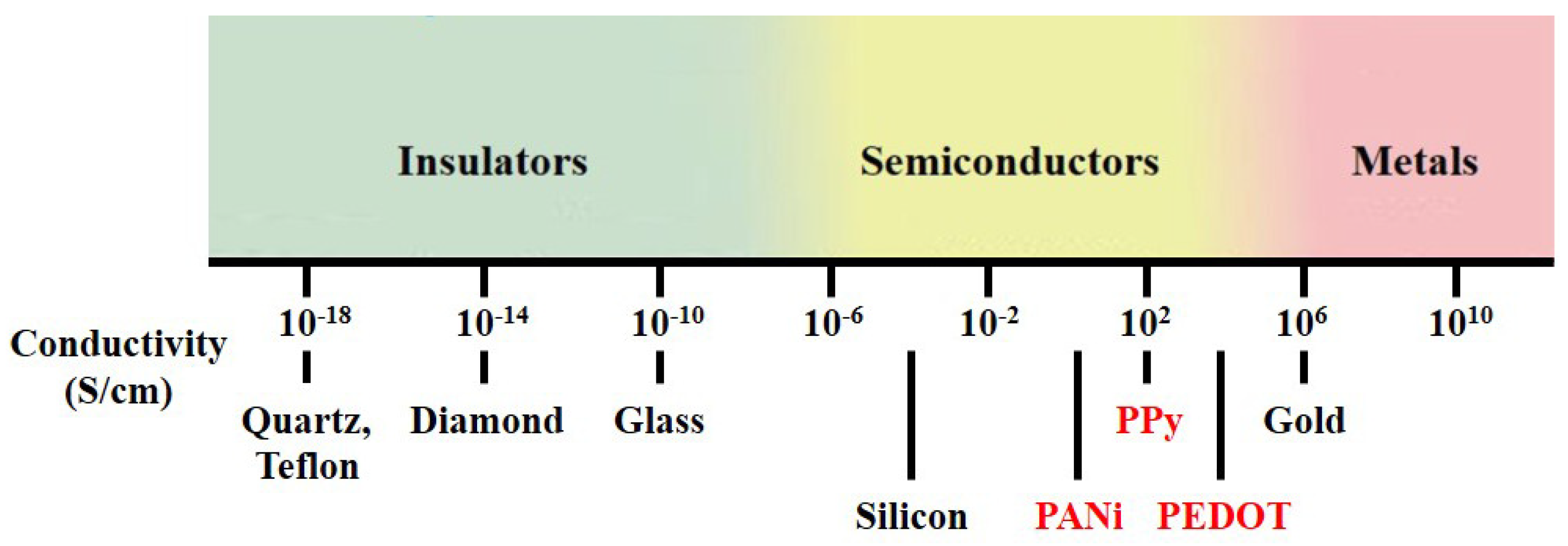

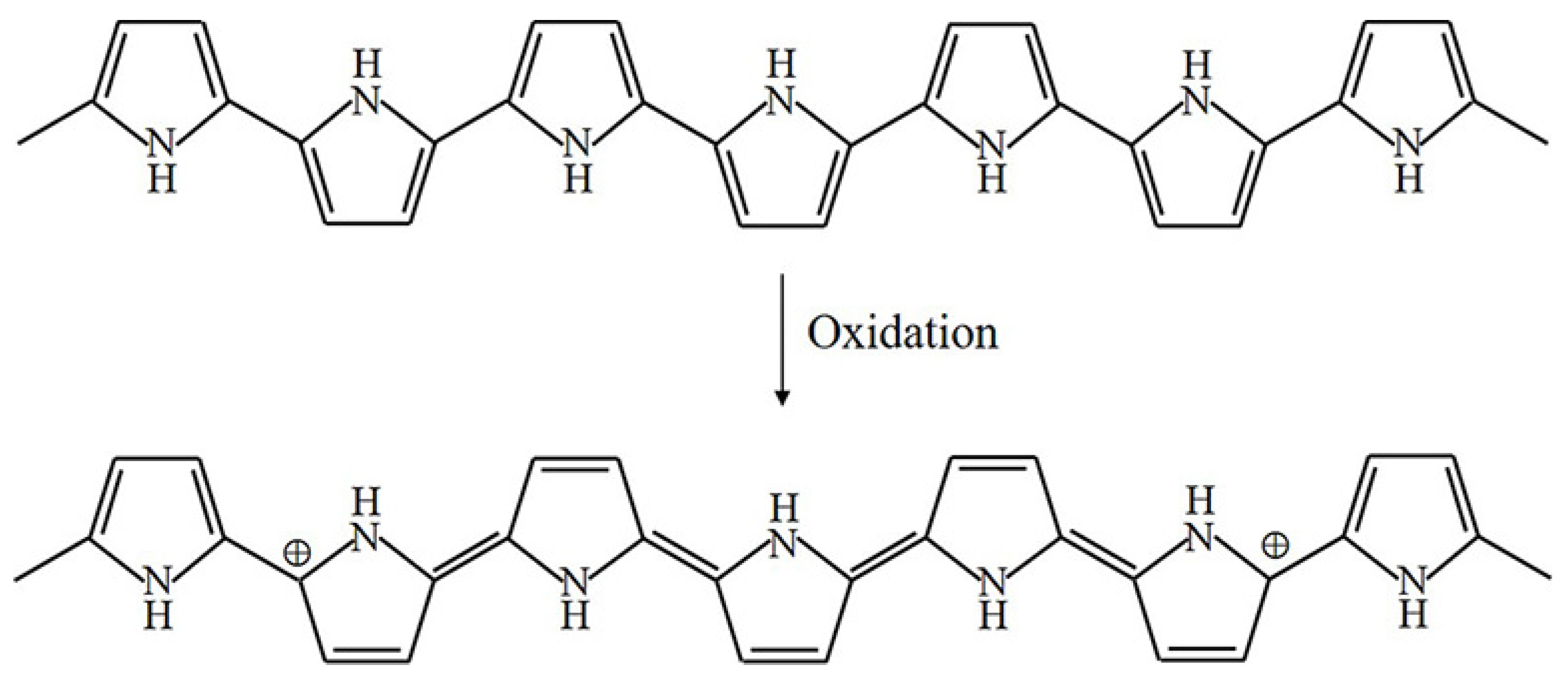
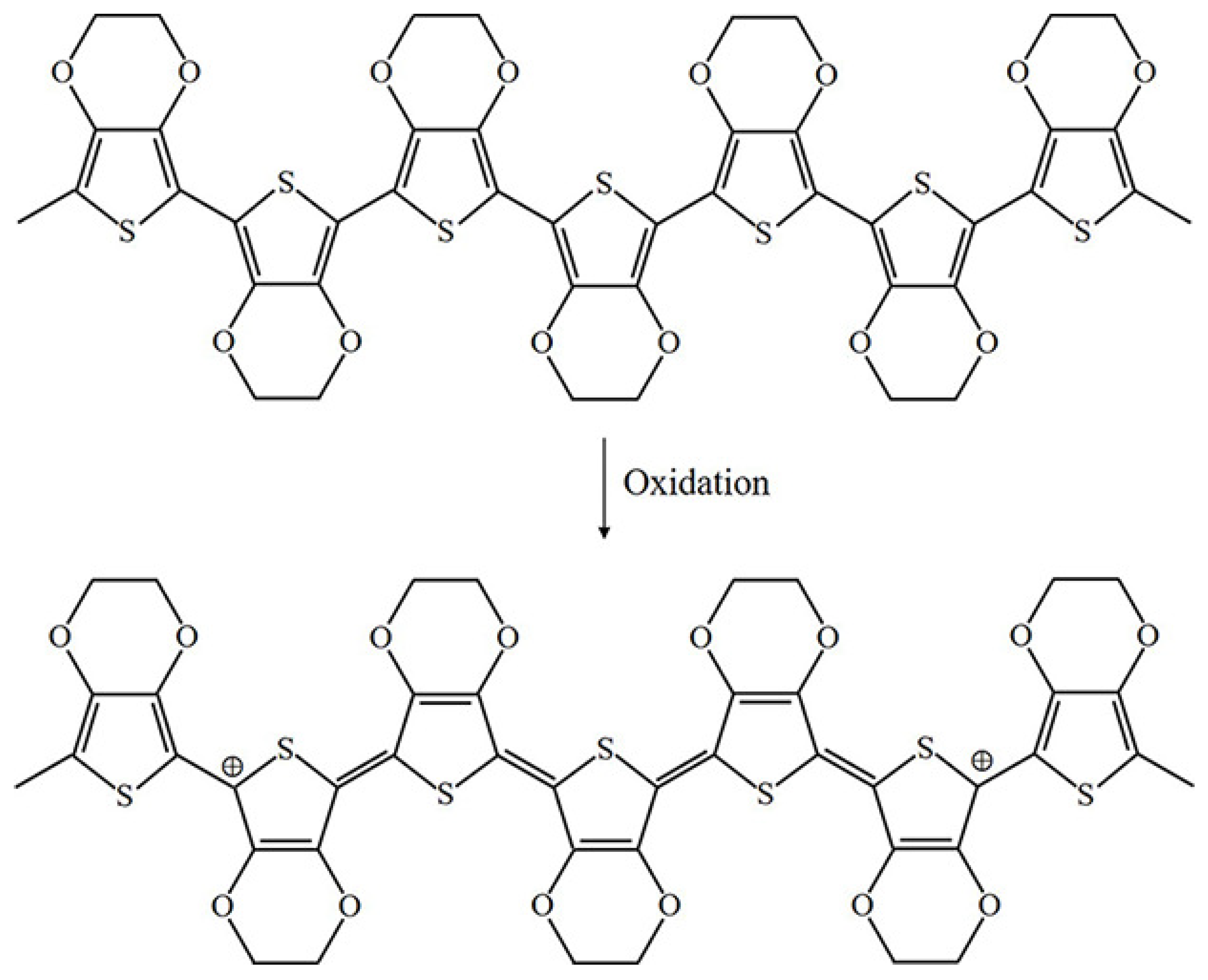



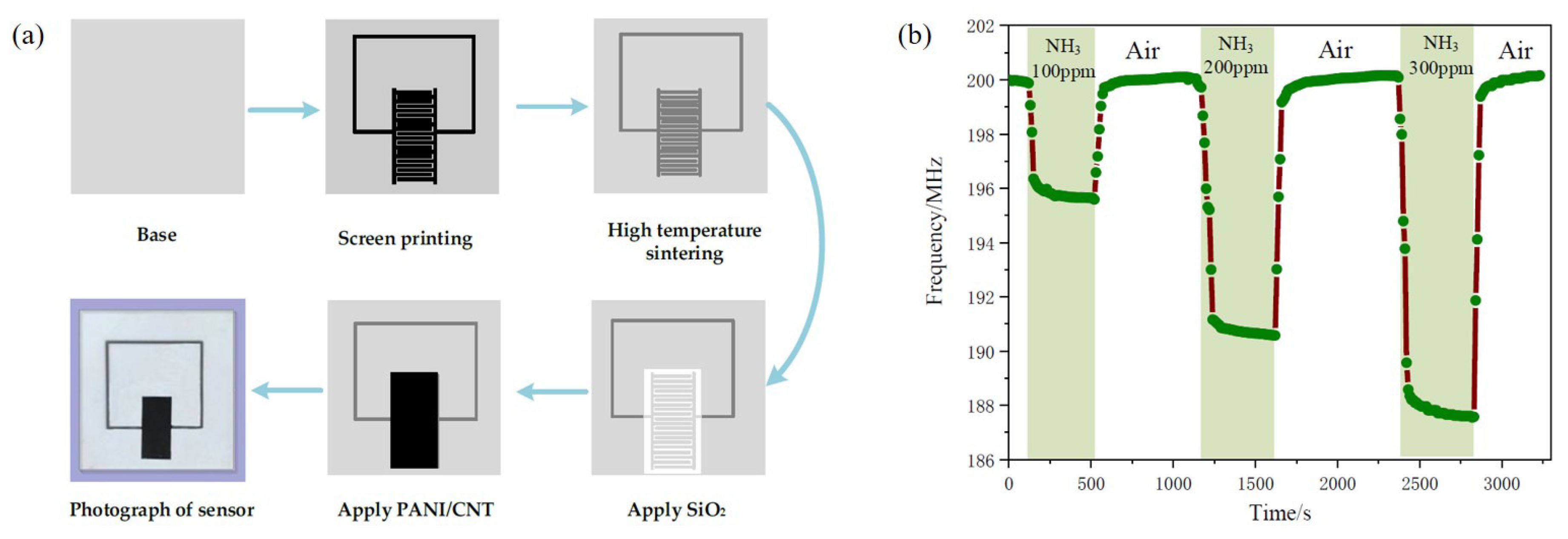

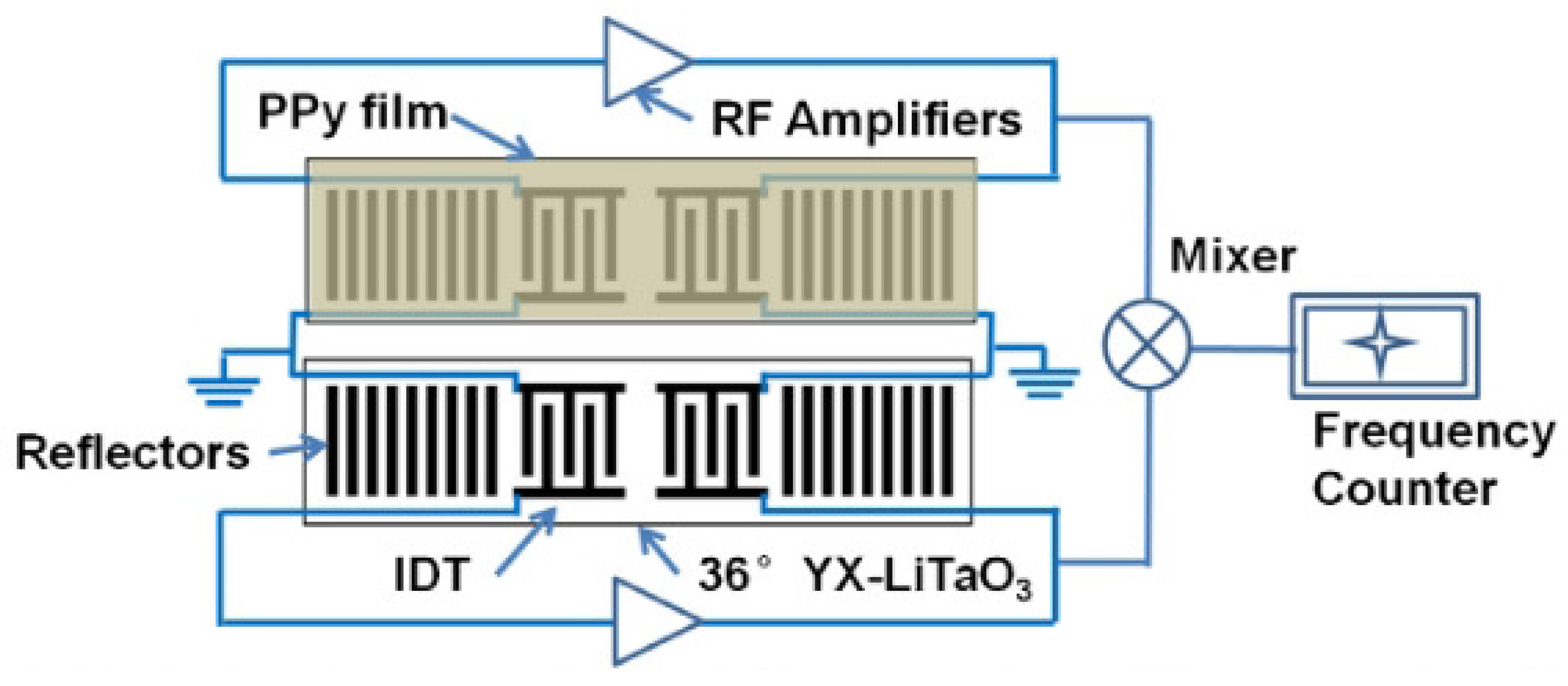

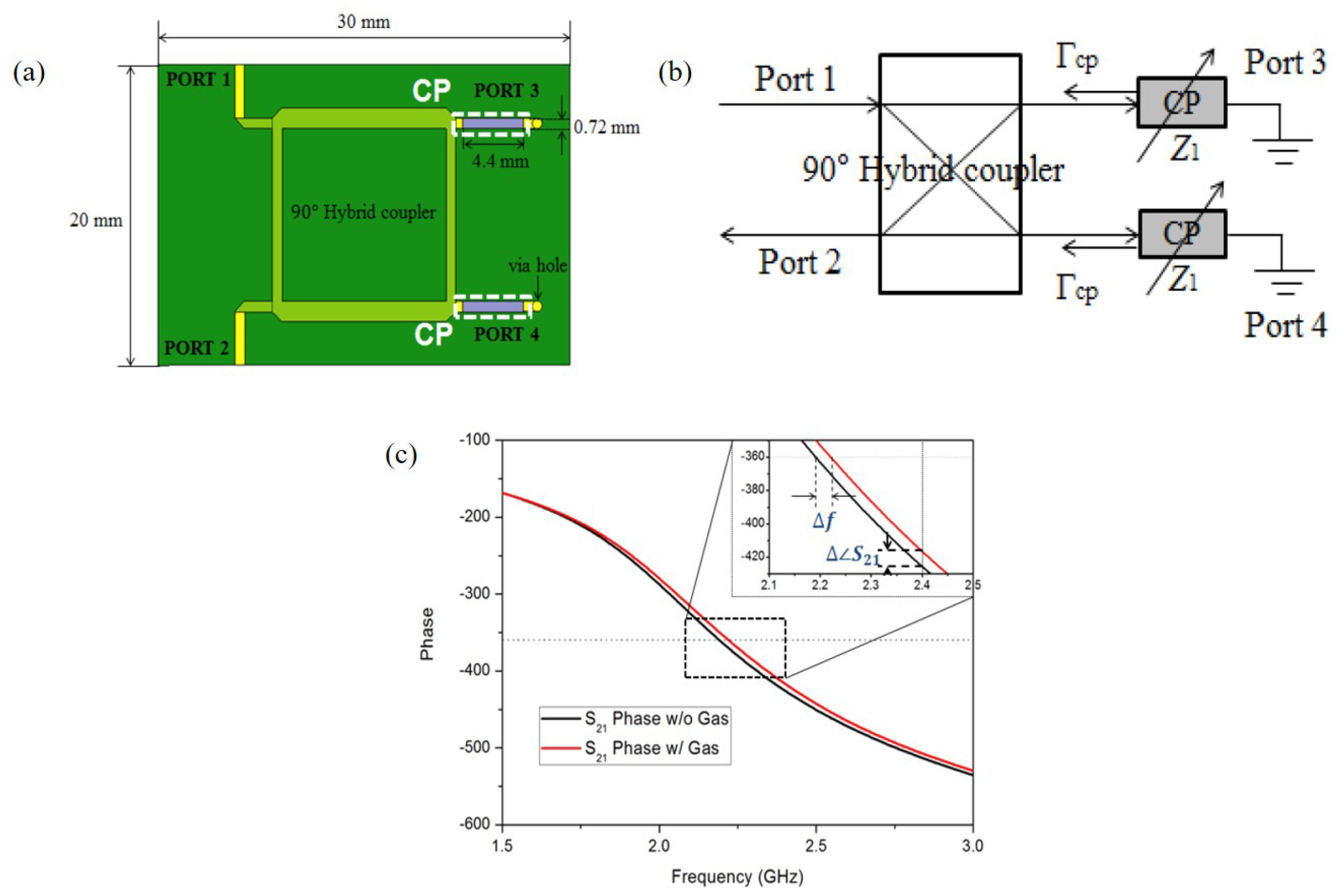
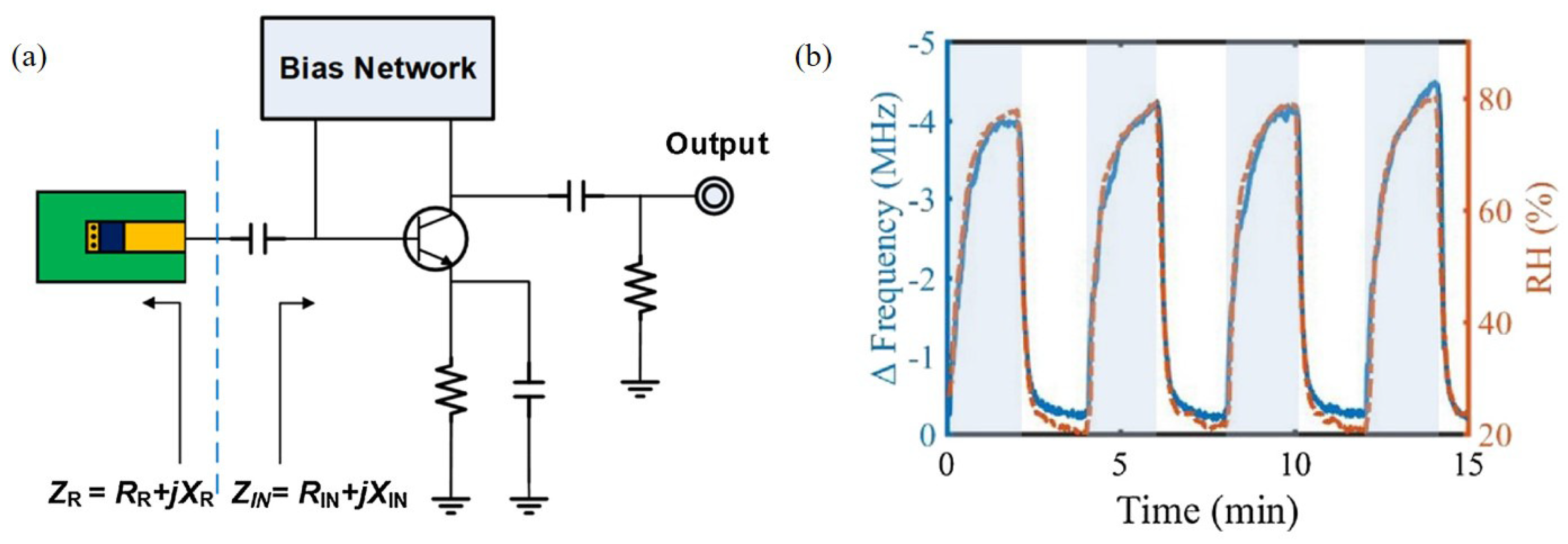


| Polymer | Conductivity (S/cm) | Structure |
|---|---|---|
| Polyaniline (PANi) | 30–200 |  |
| Polypyrrole (PPy) | 10–7500 |  |
| Poly(3,4-ethylenedioxythiophene) (PEDOT) | 0.4–400 |  |
| Polythiophene (PT) | 10–1000 |  |
| Polyacetylene (PA) | 200–1000 |  |
| Poly(p-phenylene vinylene) (PPv) | 1–1000 |  |
| Poly(p-phenylene) (PPP) | 500 |  |
| Poly(p-phenylene sulfide) (PPS) | 3–300 |  |
| Polyisothianaphthene (PITN) | 1–50 |  |
| Backbone Polymer | Component | Frequency | Detected Gas | Reference |
|---|---|---|---|---|
| PANi | SAW sensor | 148 MHz | NH | [74] |
| PANi | Interdigitated electrode | 213.6 MHz | NH | [72] |
| PANi | SAW sensor | 146 MHz | Phosphorus-containing toxic gas | [76] |
| PANi | SAW sensor | 107.2 MHz | H | [78] |
| PANi | SAW sensor | 107.2 MHz | H, CO, NO | [79] |
| PANi | Rayleigh SAW sensor | 98.47 MHz | NO | [75] |
| PANi | SAW sensor | 64.9 MHz | NO | [77] |
| PPy | RFID tag | 940 MHz | NH | [80] |
| PPy | SAW sensor | 90.6 MHz | H, NO | [81] |
| PPy | SAW sensor | 300 MHz | acetone | [82] |
| PPy | SAW sensor | 42 MHz | NH | [83,84,85] |
| PPy | SAW sensor | 123.56 MHz | NO | [86] |
| PEDOT | DSRR | 14.86 GHz | ethanol | [92] |
| PEDOT | Interdigital resonator | 3.584 GHz | NH | [88] |
| PEDOT | Hybrid coupler | 2.31 GHz | ethanol | [93] |
| PEDOT | DSRR | 2.4 GHz | water vapor | [95] |
| PEDOT | Oscillator | 916 MHz | water vapor | [94] |
| PEDOT | QCM | 12 MHz | water vapor | [89] |
| PEDOT | RFID | 850, 870, 880 MHz | water vapor | [90] |
| PEDOT | Antenna | 2.65 GHz | water vapor | [91] |
© 2020 by the authors. Licensee MDPI, Basel, Switzerland. This article is an open access article distributed under the terms and conditions of the Creative Commons Attribution (CC BY) license (http://creativecommons.org/licenses/by/4.0/).
Share and Cite
Jang, C.; Park, J.-K.; Yun, G.-H.; Choi, H.H.; Lee, H.-J.; Yook, J.-G. Radio-Frequency/Microwave Gas Sensors Using Conducting Polymer. Materials 2020, 13, 2859. https://doi.org/10.3390/ma13122859
Jang C, Park J-K, Yun G-H, Choi HH, Lee H-J, Yook J-G. Radio-Frequency/Microwave Gas Sensors Using Conducting Polymer. Materials. 2020; 13(12):2859. https://doi.org/10.3390/ma13122859
Chicago/Turabian StyleJang, Chorom, Jin-Kwan Park, Gi-Ho Yun, Hyang Hee Choi, Hee-Jo Lee, and Jong-Gwan Yook. 2020. "Radio-Frequency/Microwave Gas Sensors Using Conducting Polymer" Materials 13, no. 12: 2859. https://doi.org/10.3390/ma13122859
APA StyleJang, C., Park, J.-K., Yun, G.-H., Choi, H. H., Lee, H.-J., & Yook, J.-G. (2020). Radio-Frequency/Microwave Gas Sensors Using Conducting Polymer. Materials, 13(12), 2859. https://doi.org/10.3390/ma13122859







